Introduction
Internationalization has appeared to be one of the most noticeable trends in higher education in Canada. With its institutions, governments, and organizations devoting a considerable amount of time, energy, and resources to internationalization, it’s no surprise that its international education sector is continuously growing.
However, despite the continuous effort of Canadian institutions, some pressing concerns are still inevitable. Among the many challenges faced by Canadian colleges and institutions include lack of funding, skills gap, and global competition.
This pushes Canadian leaders and higher education institutions to establish scalable strategies in place for the coming years.
This research covers the different aspects of the international education sector in Canada including enrollment numbers, key facts and figures, emerging trends, challenges faced by Canadian institutions, and strategies to cope with these challenges.
Canada: A Popular Destination For International Students
Canada is an increasingly popular option for students who want the quality of a North American education at a less expensive cost than the US. Canadian universities bear more similarity to UK universities than they do to schools in the US.
Canadians place a great amount of importance on learning, and standards in education are uniformly high. There are almost 100 universities in Canada, five of which—the University of Toronto, McGill University, University of British Columbia, Université de Montréal, and University of Alberta—are ranked among the top 100 in the world.
Key Facts & Figures
- There were about 1,034,000 full-time, 281,000 part-time and an estimated 400,000 continuing education students in
- Between March 2008 and March 2017, there were 1,574,200 new jobs created for university graduates – almost three times those created for graduates of all other types of post-secondary education
- As a $35 billion enterprise in direct expenditures, universities are significant drivers of economic prosperity. They provide employment to roughly 250,000
- Well over two-thirds of Canada’s universities are working to include Indigenous representation within their governance or leadership
- Two-thirds of universities are incorporating Indigenous knowledge, methods and protocols into research and teaching policies, programs and
- 78% of universities promote intercultural engagement through cultural activities, events, talking circles and cultural competency or reconciliation training.
- More than half of today’s undergraduates benefit from experiential learning – such as co-ops, internships, and service learning – as part of their university education.
- Only 11% of Canadian undergraduates undertake an international mobility experience over the course of their degree, despite the clear benefits of global study to building future
- More than 80% of employers that hire graduates with international and intercultural experience say these recruits enhance their company’s competitiveness.
- The majority of universities offer their students international experiences such as academic coursework, field schools, volunteer work, research abroad and foreign work.
Insights on Canadian Higher Education
When it comes to securing market share, Canada’s growth has skyrocketed since the beginning of the century. In 2001, Canada didn’t make it to the Top Host Destinations for international students. Conversely, in 2017, Canadian institutions show the same data.
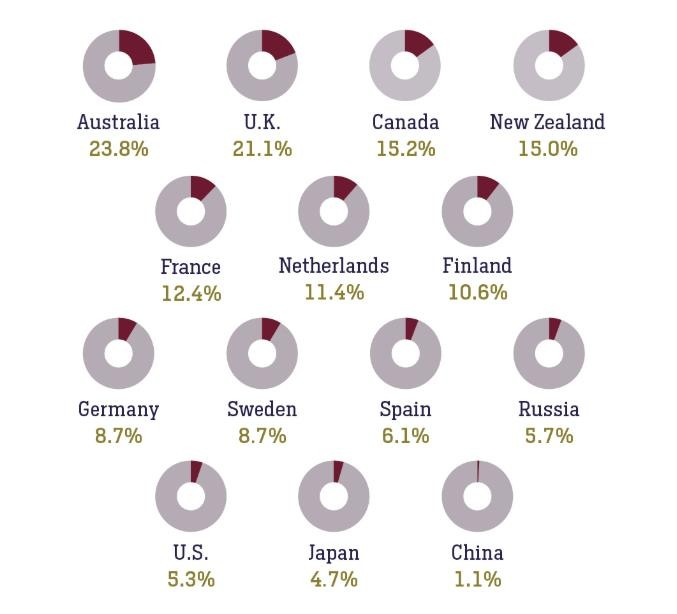
Figure 1: International Students as a percentage of Total Higher education Source: http://www.immigrationnews.ca/2018/06/08/highest-international-students/
Student Mobility
IIE’s Open Doors 2017 Report tells us that Canada is still the fifth largest source country of international students going to the US, with some 27,000 Canadian students enrolled in US universities in the last 2016/2017 academic year. With these high numbers, American universities and colleges are well advised to direct their focus to this market.
Similarly, Canadian students are in the top 10 of international students in UK universities (almost 8,000 students), and about 4,700 Canadians were studying in Australian universities in the past year. Other popular destinations are New Zealand, Italy, Spain, France, Singapore and Japan, to name a few.
In addition to university studies, Canadians are going abroad to volunteer, learn a second – or third – language, and are looking for gap year/career break experiences.
Enrollment Numbers and Trends
There are 96 Canadian public and private nonprofit universities and university- degree level colleges in Canada, plus about 80 community colleges. Education is regionalized, with each province having its own Ministry of Education. With high enrollment to the point of some programs lacking space – in particular at the graduate level – Canadians are looking beyond their provincial and country borders for options.
This statistic shows the total number of students enrolled in post-secondary institutions in Canada in the academic year 2016/17. In 2017, a total of 810,060 students were enrolled in post-secondary institutions in Ontario.
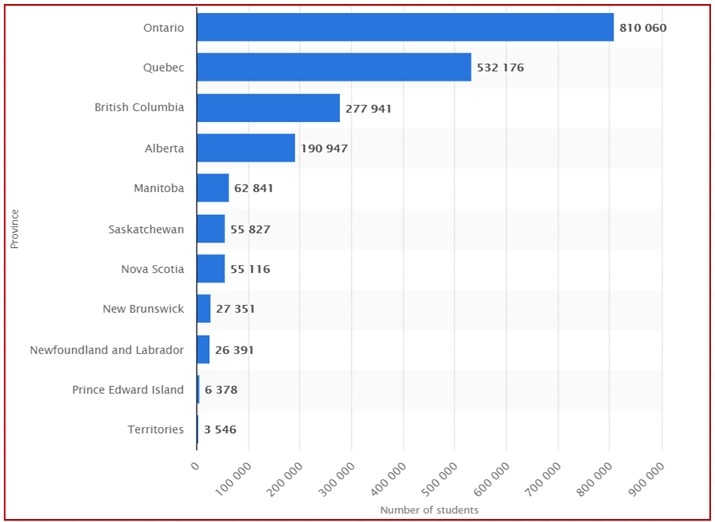
Graph 1: Number of students enrolled in post-secondary institutions in Canada in 2016/17, by province. Source: https://www.statista.com/statistics/447802/enrollment-of-postsecondary- students-in-canada-by-province/
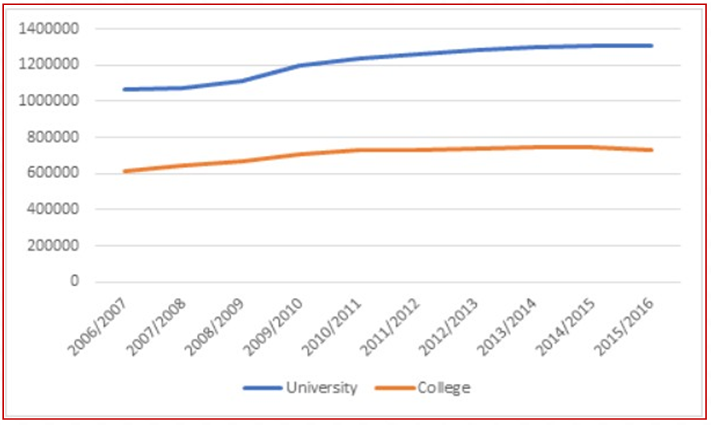
Graph 2: Total enrollments by Institution Type, Canada, 2006-07 to 2015-16 Source: http://higheredstrategy.com/student-numbers/
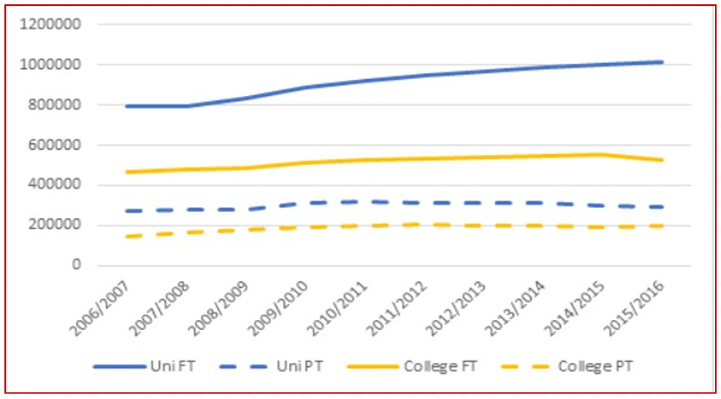
Graph 3: Total enrollments by Institution Type and Student Status, Canada, 2006-07 to 2015-16 Source: http://higheredstrategy.com/student-numbers/
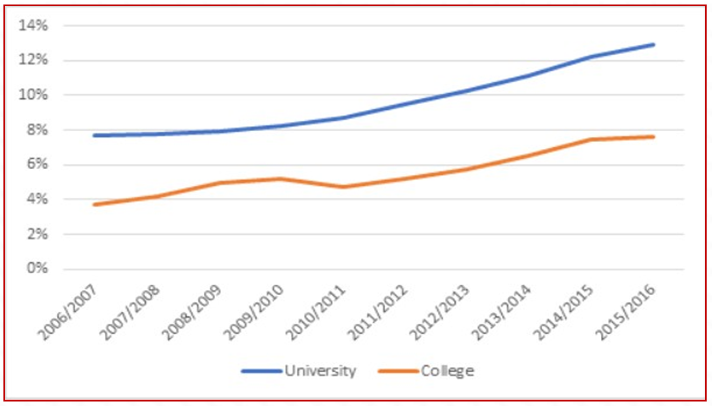
Graph 4: International enrollments as a percentage of total enrollments, Canada, 2006-07 to 2015-16 Source: http://higheredstrategy.com/student-numbers/
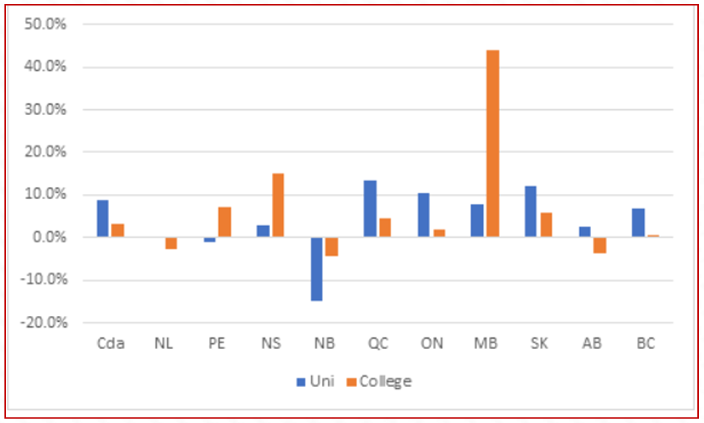
Figure 2: Total enrollments by Institution Type and Province, Canada, 2009-10 to 2015-16 Source: http://higheredstrategy.com/student-numbers/
Trends in International Student Enrollment Comparison
Further study sites like Roslyn Kunin and Associates (RKA) came up with a data of the associated economic impacts of student enrollment in Canada in five years – 2008, 2010, 2014, 2015, and 2016. This was completed in four separate studies, dated 2009, 2012, 2016, and 2017.
The table below shows the comparable values, along with trends of international student enrollment in five years.

Figure 3: Comparing the number of international students in Canada, 2008, 2010 and 2014-2016 Source: https://www.international.gc.ca/education/report-rapport/impact-2017/sec-5.aspx?lang=eng
Analysis
Between 2008 and 2016, the number of international students studying in Canada increased by 87.0% at an average annual rate of 8.1%. The increase is mainly attributed to the number of long-term students, those who study longer than six months in a given year. Enrollment in this category of students more than doubled between 2008 and 2016, growing at 10.9% per year.
Between 2015 and 2016, the number of international students grew an impressive 14.4%, most of which were the results of an increase in long-term students from India studying at the college level.
Biggest Senders
According to ICEF Monitor, as of December 31 2017, there were 494,525 international students enrolled in Canadian institutions and schools. This means a significant increase of 20% over the year before, and this is the time that Canada has hit its long- term target – to host 450,000 international students by 2022. Meanwhile, the number of international students enrolled in Canadian institutions has jumped to 120% between 2010 and 2017, and by 41% between 2015 and 2017 alone. Experts stress that international students choose Canada because of the quality of the Canadian education system and its reputation as a safe country.
The chart below shows that China and India are the biggest senders of students to Canada.
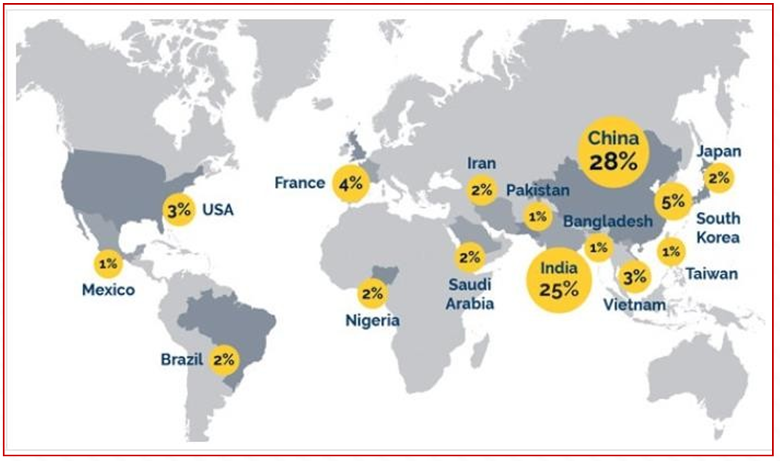
Figure 4: Major sending markets for international students in Canada, 2017 Source: http://monitor.icef.com/2018/03/canada-books-20-growth-2017/
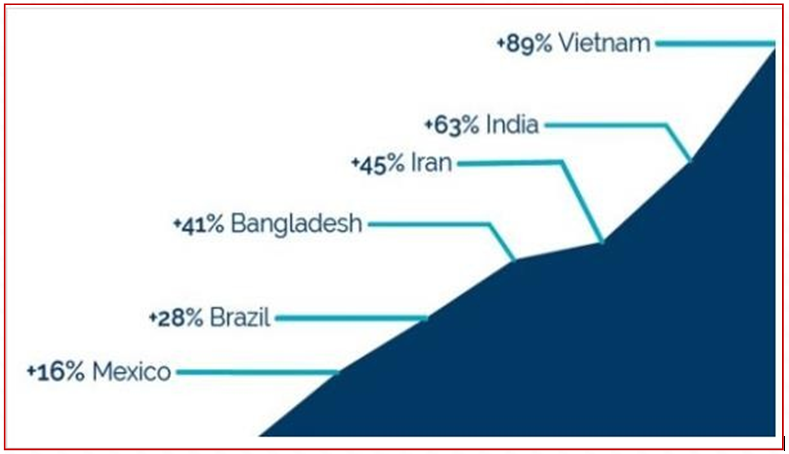
Graph 5: Canada’s fastest-growing markets for 2017
Source: http://monitor.icef.com/2018/03/canada-books-20-growth-2017/
Emerging Trends in 2021
Changing Student Expectations
Students are looking for access to quality programs providing flexible options supported by coaches, guides and mentors who can personalize learning as well as leverage the knowledge and skills the learner brings to their studies. Many more are now looking at university + college courses, suggesting that the boundaries between such institutions will shift. By 2030, more joint or seamless programs will be in place. They are looking at shorter programs with much more acceptance of credit transfer, work- based learning credit, and prior learning assessment, which is efficient and not cumbersome. The emergence of so-called “microcredit” (e.g. badges), short courses, accelerated degrees and joint college: university integrated programs are all responses to this need.
Internalization
More programs in Canadian universities include international study components, and more students are completing part of their Canadian programs abroad. More learners are coming to Canada with part of a program completed in another country and more courses have international components and links to international research, applied research, or organizations. Higher education is an increasingly international business. To give just statistics, universities and colleges worldwide will soon be competing for over 8 million international students.
Key Issues Facing Canadian Institutions
Lack of Funding
During the first part of 2013, there were lots of headlines announcing faculty layoffs, program or budget cuts and the lack of support for the sciences. Most of these announcements came on the heels of provincial governments reducing operating funds to institutions, or program cuts by the federal government. This is a serious problem that hinders the growth of the international market.
Producing Job-Ready Graduates
Canadian universities need to make significant changes like altering their curriculum or changing program structures. Universities are challenged to adjust their programs for the market demand in a very uncertain and unpredictable environment.
The Skills Gap
The federal government has identified a labor shortage and skills gap as priorities, while others question their existence. Universities must provide broad intellectual and personal development that enables graduates to thrive in a world that is constantly changing and demands innovation and adaptability.
Expectations
There is much discussion on the need for differentiation among higher education institutions, both in Canada and abroad. Universities will be challenged to define the value proposition that their particular institution offers. Added to this are expectations from the government on the role universities play in commercialization.
Global Competition
While all of these issues are playing out domestically, they are outweighed by a globally competitive environment by many high-performing countries, and that may be the greatest challenge to the Canadian international education market.
Canadian International Education Strategy
Support Canadian post-secondary students and young people pursuing opportunities to travel, study, and work overseas
Attract more top-tier international students to Canada by promoting Canadian educational institutions as high-caliber places to study
Budget 2019 proposes to invest $147.9 million over five years and $8.0 million per year ongoing
In an increasingly global economy and labor market, Canadian students benefit from a range of skills that include adaptability, fluency in more than one or two languages, and intercultural knowledge. This funding will be used to help more Canadian students participate in the study, work, and travel opportunities abroad as well as invest in promotional activities to ensure that international students continue choosing Canada as their study destination of choice.
Conclusion
More and more high schools and universities in Canada are encouraging overseas studies, and education consulting is becoming increasingly popular across the country. Universities in Canada have called for a doubling in the number of undergraduates taking study-abroad programs, to 50,000 a year from the current 25,000.
Currently, Canadian universities are facing key challenges but strategic leaders continuously establish scalable solutions to hit long-term end goals. In terms of international recruitment marketing, the strategy will focus more on diversifying Canada’s international enrollment base. Besides, despite all the challenges, we can still see the continued attractiveness of Canada as a study destination for international students.
